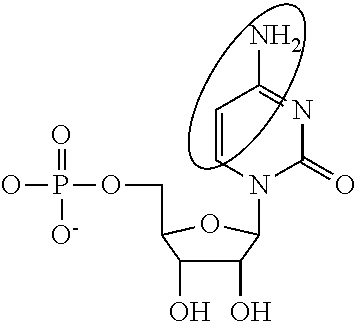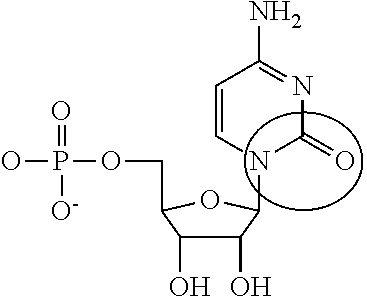Modified mrnas encoding cell-penetrating polypeptides
a polypeptide and mrna technology, applied in the field of manufacture of modified mrna, can solve the problems of difficult to obtain dna expression in cells, alterations and/or damage to the genomic dna of host cells,
- Summary
- Abstract
- Description
- Claims
- Application Information
AI Technical Summary
Benefits of technology
Problems solved by technology
Method used
Image
Examples
example 1
Modified mRNA Production
[0549]Modified mRNAs according to the invention are made using standard laboratory methods and materials.
[0550]The open reading frame with various upstream or downstream additions β-globin, tags, etc.) is ordered from DNA2.0 (Menlo Park, Calif.) and typically contains a multiple cloning site with XbaI recognition. Upon receipt of the construct, it is reconstituted and transformed into chemically competent E. coli. For the present invention, NEB DH5-alpha Competent E. coli are used. A typical clone map is shown in FIG. 1. Transformations are performed according to NEB instructions using 100 ng of plasmid. The protocol is as follows:[0551]1. Thaw a tube of NEB 5-alpha Competent E. coli cells on ice for 10 minutes.[0552]2. Add 1-5 μl containing 1 pg-100 ng of plasmid DNA to the cell mixture. Carefully flick the tube 4-5 times to mix cells and DNA. Do not vortex.[0553]3. Place the mixture on ice for 30 minutes. Do not mix.[0554]4. Heat shock at 42° C. for exactly...
example 2
PCR for cDNA Production
[0564]PCR procedures for the preparation of cDNA is performed using 2×KAPA HiFi™ HotStart ReadyMix by Kapa Biosystems (Woburn, Mass.). This system includes 2×KAPA ReadyMixl2.5 μl; Forward Primer (10 uM) 0.75 μl; Reverse Primer (10 uM) 0.75 μl; Template cDNA 100 ng; and dH20 diluted to 25.0 μl. The reaction conditions are at 95° C. for 5 min. and 25 cycles of 98° C. for 20 sec, then 58° C. for 15 sec, then 72° C. for 45 sec, then 72° C. for 5 min. then 4° C. to termination.
[0565]The reverse primer of the instant invention incorporates a poly-T120 for a poly-A120 in the mRNA. Other reverse primers with longer or shorter poly(T) tracts can be used to adjust the length of the poly(A) tail in the mRNA.
[0566]The reaction is cleaned up using Invitrogen's PureLink™ PCR Micro Kit (Carlsbad, Calif.) per manufacturer's instructions (up to 5 μg). Larger reactions will require a cleanup using a product with a larger capacity. Following the cleanup, the cDNA is quantified u...
example 3
In Vitro Transcription
[0567]The in vitro transcription reaction generates mRNA containing modified nucleotides or modified RNA. The input nucleotide triphosphate (NTP) mix is made in-house using natural and unnatural NTPs.
[0568]A typical in vitro transcription reaction includes the following:
1.Template cDNA1.0μg2.10x transcription buffer2.0μl(400 mM Tris-HCl pH 8.0, 190 mM MgCl2,50 mM DTT, 10 mM Spermidine)3.Custom NTPs (25 mM each)7.2μl4.RNase Inhibitor20U5.T7 RNA polymerase3000U6.dH20Up to 20.0μl. and7.Incubation at 37° C. for 3 hr-5 hrs.
[0569]The crude IVT mix may be stored at 4° C. overnight for cleanup the next day. 1 U of RNase-free DNase is then used to digest the original template. After 15 minutes of incubation at 37° C., the mRNA is purified using Ambion's MEGAclear™ Kit (Austin, Tex.) following the manufacturer's instructions. This kit can purify up to 500 μg of RNA. Following the cleanup, the RNA is quantified using the NanoDrop and analyzed by agarose gel electrophoresi...
PUM
| Property | Measurement | Unit |
|---|---|---|
| pore size | aaaaa | aaaaa |
| pore size | aaaaa | aaaaa |
| pore size | aaaaa | aaaaa |
Abstract
Description
Claims
Application Information
 Login to View More
Login to View More - R&D
- Intellectual Property
- Life Sciences
- Materials
- Tech Scout
- Unparalleled Data Quality
- Higher Quality Content
- 60% Fewer Hallucinations
Browse by: Latest US Patents, China's latest patents, Technical Efficacy Thesaurus, Application Domain, Technology Topic, Popular Technical Reports.
© 2025 PatSnap. All rights reserved.Legal|Privacy policy|Modern Slavery Act Transparency Statement|Sitemap|About US| Contact US: help@patsnap.com



